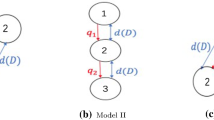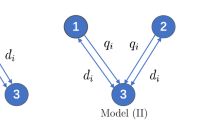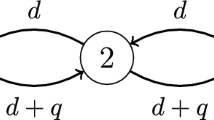Abstract
We study the dynamics of two competing species in three-patch models and illustrate how the topology of directed river network modules may affect the evolution of dispersal. Each model assumes that patch 1 is at the upstream end, patch 3 is at the downstream end, but patch 2 could be upstream, or middle stream, or downstream, depending on the specific topology of the modules. We posit that individuals are subject to both unbiased dispersal between patches and passive drift from one patch to another, depending upon the connectivity of patches. When the drift rate is small, we show that for all models, the mutant species can invade when rare if and only if it is the slower disperser. However, when the drift rate is large, most models predict that the faster disperser wins, while some predict that there exists one evolutionarily singular strategy. The intermediate range of drift is much more complex: most models predict the existence of one singular strategy, but it may or may not be evolutionarily stable, again depending upon the topology of modules, while one model even predicts that for some intermediate drift rate, singular strategy does not exist and the faster disperser wins the competition.






Similar content being viewed by others
References
Ballyk M, Dung L, Jones DA, Smith HL (1998) Effects of random motility on microbial growth and competition in a flow reactor. SIAM J Appl Math 59:573–596
Cantrell RS, Cosner C, DeAngelis DL, Padrón V (2007) The ideal free distribution as an evolutionarily stable strategy. J Biol Dyn 1:249–271
Cantrell RS, Cosner C, Lou Y (2012) Evolutionary stability of ideal free dispersal strategies in patchy environments. J Math Biol 65:943–965
Cantrell RS, Cosner C, Lam K-Y (2017) On resident-invader dynamics in infinite dimensional dynamical systems. J Differ Equ 263:4565–4616
Cantrell RS, Cosner C, Lou Y, Schreiber S (2017) Evolution of natal dispersal in spatially heterogeneous environments. Math Biosci 283:136–144
DeAngelis DL, Wolkowicz G, Lou Y, Jiang Y, Novak M, Svanback R, Araujo M, Jo YS, Cleary EA (2011) The effect of travel loss on evolutionarily stable distributions of populations in space. Am Nat 178:15–29
Dieckmann U, Law R (1996) The dynamical theory of coevolution: a derivation from stochastic ecological processes. J Math Biol 34:579–612
Dockery J, Hutson V, Mischaikow K, Pernarowski M (1998) The evolution of slow dispersal rates: a reaction-diffusion model. J Math Biol 37:61–83
Du Y, Lou B, Peng R, Zhou M (2020) The Fisher-KPP equation over simple graphs: varied persistence states in river networks. J Math Biol 80:1559–1616
Fagan WF (2002) Connectivity, fragmentation, and extinction risk in dendritic metapopulations. Ecology 83:3243–3249
Geritz SAH, Kisdi E, Meszena G, Metz JAJ (1998) Evolutionarily singular strategies and the adaptive growth and branching of the evolutionary tree. Evol Ecol 12:35–57
Golubitsky M, Hao W, Lam K-Y, Lou Y (2017) Dimorphism by singularity theory in a model for river ecology. Bull Math Biol 79:1051–1069
Grant EHC, Lowe WH, Fagan WF (2007) Living in the branches: population dynamics and ecological processes in dendritic networks. Ecol Lett 10:165–175
Hamida Y (2017) The evolution of dispersal for the case of two patches and two-species with travel loss, M.S. Thesis, Ohio State University
Hao WR, Lam K-Y, Lou Y Ecological and evolutionary dynamics in advective environments: Critical domain size and boundary conditions, Discrete Contin Dyn Syst Ser B (in press)
Hastings A (1983) Can spatial variation alone lead to selection for dispersal? Theor Popul Biol 24:244–251
Huang Q, Jin Y, Lewis MA (2016) R0 analysis of a benthic-drift model for a stream population. SIAM J Appl Dyn Syst 15:287–321
Jin Y, Lewis MA (2011) Seasonal influences on population spread and persistence in streams II: Critical domain size. SIAM J Appl Math 71:1241–1262
Jin Y, Lewis MA (2012) Seasonal influences on population spread and persistence in streams: Spreading speeds. J Math Biol 65:403–439
Jin Y, Hilker F, Steffler P, Lewis MA (2014) Seasonal invasion dynamics in a spatially heterogeneous river with fluctuating flows. Bull Math Biol 76:1522–1565
Jin Y, Peng R, Shi JP (2019) Population dynamics in river networks. J Nonlinear Sci 29:2501–2545
Jin Y, Huang Q, Steffler PM, Lewis MA (2019) Population persistence of a benthic-drift model in a depth-averaged river. AIMS Math 4(6):1768–1795
Kirkland S, Li C-K, Schreiber SJ (2006) On the evolution of dispersal in patchy environments. SIAM J Appl Math 66:1366–1382
Lam K-Y, Lou Y, Lutscher F (2014) Evolution of dispersal in closed advective environments. J Biol Dyn 9(Suppl. 1):188–212
Lam K-Y, Lou Y, Lutscher F (2016) The emergence of range limits in advective environments. SIAM J Appl Math 76:641–662
Levin SA, Cohen D, Hastings A (1984) Dispersal strategies in patchy environments. Theor Popul Biol 26:165–191
Lou Y (2019) Ideal free distribution in two patches. J Nonlinear Model Anal 2:151–167
Lou Y, Lutscher F (2014) Evolution of dispersal in open advective environments. J Math Biol 69:1319–1342
Lou Y, Zhou P (2015) Evolution of dispersal in advective homogeneous environment: the effect of boundary conditions. J Differ Equ 259:141–171
Lou Y, Xiao D, Zhou P (2016) Qualitative analysis for a Lotka–Volterra competition system in advective homogeneous environment. Discrete Contin Dyn Syst Ser A 36:953–969
Lou Y, Zhao X-Q, Zhou P (2019) Global dynamics of a Lotka–Volterre competition-diffusion-advection system in heterogeneous environments. J Math Pure Appl 121:47–82
Lutscher F, Pachepsky E, Lewis MA (2005) The effect of dispersal patterns on stream populations. SIAM Rev 47:749–772
Lutscher F, Lewis MA, McCauley E (2006) Effects of heterogeneity on spread and persistence in rivers. Bull Math Biol 68:2129–2160
Lutscher F, McCauley E, Lewis MA (2007) Spatial patterns and coexistence mechanisms in systems with unidirectional flow. Theor Popul Biol 71:267–277
Maynard-Smith J, Price GR (1973) The logic of animal conflict. Nature 246:15–18
McPeek MA, Holt RD (1992) The evolution of dispersal in spatially and temporally varying environments. Am Nat 140:1010–1027
Noble L (2015) Evolution of Dispersal in Patchy Habitats, Ph.D Thesis, Ohio State University. http://orcid.org/0000-0002-2092-2817
Pachepsky E, Lutscher F, Nisbet RM, Lewis MA (2015) Persistence, spread and the drift paradox. Theor Popul Biol 67:61–73
Ramirez JM (2012) Population persistence under advection-diffusion in river networks. J Math Biol 65:919–942
Samia Y, Lutscher F, Hastings A (2015) Connectivity, passability and heterogeneity interact to determine fish population persistence in river networks. J R Soc Interface 12:20150435
Sarhad J, Carlson R, Anderson KE (2014) Population persistence in river networks. J Math Biol 69:401–448
Speirs DC, Gurney WSC (2001) Population persistence in rivers and estuaries. Ecology 82:1219–1237
Vasilyeva O (2017) Competition of multiple species in advective environments. Bull Math Biol 79:1274–1294
Vasilyeva O, Lutscher F (2011) Population dynamics in rivers: analysis of steady states. Can Appl Math Quart 18:439–469
Vasilyeva O, Lutscher F (2012) Competition of three species in an advective environment. Nonlinear Anal RWA 13:1730–1748
Vasilyeva O, Lutscher F (2012) Competition in advective environments. Bull Math Biol 74:2935–2958
Wang Y, Shi JP (2019) Persistence and extinction of population in reaction-diffusion-advection model with weak Allee effect growth. SIAM J Appl Math 79:1293–1313
Wang Y, Shi JP (2020) Dynamics of a reaction-diffusion Benthic-drift model with strong Allee effect growth. J Differ Equ 269:7605–7642
Wang Y, Shi JP, Wang JF (2019) Persistence and extinction of population in reaction-diffusion-advection model with strong Allee effect growth. J Math Biol 78:2093–2140
Xiang J, Fang Y (2019) Evolutionarily stable dispersal strategies in a two-patch advective environment. Discrete Contin Dyn Syst Ser B 24:1875–1887
Zhang B, Lam K-Y, Ni W-M, Collins KM, Fu Z, Zhai L, Lou Y, DeAngelis DL, Hastings A (2020) Directed movement changes coexistence outcomes in heterogeneous environments, submitted 28pp
Zhao X-Q, Zhou P (2016) On a Lotka–Volterra competition model: the effects of advection and spatial variation. Calc Var Partial Diff 55:73
Zhou P (2016) On a Lotka–Volterra competition system: diffusion vs advection. Calc Var Partial Diff 55:137
Acknowledgements
The authors sincerely thank two anonymous referees for their insightful comments and suggestions. HYJ is partially supported by the NSFC grant No. 11571364. KYL and YL are partially supported by the NSF grant DMS-1853561.
Author information
Authors and Affiliations
Corresponding author
Additional information
Publisher's Note
Springer Nature remains neutral with regard to jurisdictional claims in published maps and institutional affiliations.
Rights and permissions
About this article
Cite this article
Jiang, H., Lam, KY. & Lou, Y. Are Two-Patch Models Sufficient? The Evolution of Dispersal and Topology of River Network Modules. Bull Math Biol 82, 131 (2020). https://doi.org/10.1007/s11538-020-00803-1
Received:
Accepted:
Published:
DOI: https://doi.org/10.1007/s11538-020-00803-1




